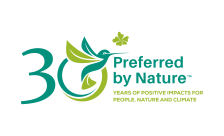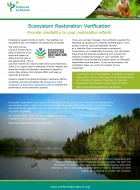Reap the benefits of providing assurance for your ecosystem restoration efforts through Ecosystem Restoration verification.
Field verification of performance in implementing forest ecosystem restoration, where the restoration is technically, environmentally, socially and economically appropriate, is key to achieving the impacts expected.
This verification approach places emphasis on field performance versus documentation.
- For larger-scale efforts (over 10,000 ha), more documentation is expected and would be used to address some verification requirements.
- For smaller-scale and community-led efforts, less documentation may be required, expecting that the verification report will document, in writing, key information that is required and that will become part of the due diligence record.
The proposed approach creates a series of “core” and “continuous improvement” indicators.
- “Core” means those which shall be assessed/verified in every situation, with positive performance at the field level considered crucial/required in all cases.
- “Continuous improvement” means partial success in implementation is acceptable, if credible field level progress is evident.
Click the tabs below to learn more.
Get started
Verification approach
The Ecosystem Restoration proposed verification approach recognises the evolving nature of restoration and related due diligence efforts around the globe, and the fast-paced development of information technology or remote sensing that can be used to assess such efforts.
Restoration activity
This verification approach does not presuppose that one technical restoration intervention is the best for obtaining results. Alternatives may include tree plantations, agroforestry, natural forest management, enrichment planting, rewilding, improved pastoralism, regenerative agriculture etc. In some cases, a combination of techniques may be the most appropriate.
Socio-economic aspects
This approach does recognise that it is critical to consider economic and social factors beyond the original or reference ecosystems. Successful ‘ecological’ restoration cannot ignore economic and social factors or community needs. This may lead to blended approaches that initially – or even later in the restoration cycle – include actions to produce products or ecosystem services of value to communities or companies.
Smallholders and Communities (SH&C)
Placing SH&C at the centre is a key principle of this standard, as we acknowledge that these groups get involuntarily marginalised by the schemes as they get too complex and thus, costly to comply with when they are the ones that want to use the standard to improve their practises or communicate about their efforts. As such, some of the key considerations taken include:
- reducing the documentation required to a minimum,
- reducing audit frequency wherever possible depending on the assessed risk,
- promoting the use and training of local experts to empower local parties while reducing audit costs, and
- emphasising the use of Information and Communication Technology to reduce audit costs.
Project validation
In the case of a proposed restoration for which management activities have only recently started and can only be partially demonstrated, confirmation that the organisation complies with all applicable requirements of this procedure and has a credible plan that is likely to lead to successful verification is an option, referred to here as validation.
The proposed verification approach consists of:
 |
Identifying Restoration Manager. The individual responsible for implementing restoration and meeting verification requirements at the field level is identified. |
 |
Stakeholder engagement. Primary stakeholders are consulted prior to or during the field verification. |
 |
Performance review. An effectiveness review is conducted, adapted to risk, scale and intensity for Smallholders and Communities (SH&Cs) and medium projects and annually for large projects. |
 |
Audit report. The auditor prepares a draft, which the Restoration Manager then reviews. Any major non-conformity reported shall be closed before verification is granted. |
 |
Public summary and claim. A public summary of the report is made available on the Preferred by Nature website. For public claims to be made, they must first be reviewed and approved by our auditor or accountability system. |
Our experience
With over 25 years of delivering sustainability certification services to organisations in more than 100 countries, our experts are equipped to provide you with the credibility and guidance you need to provide accountability for your ecosystem restoration practices.
By partnering with us you not only enhance your own sustainability initiatives, but also help us realise our mission and strategy.
- Industry and auditing expertise. We draw on over 25 years of experience delivering sustainability certification services to businesses around the world, particularly to the land-use sector. To date, we have certified over 80+ million hectares of forest land against international sustainability standards.
- Accessible for all. We cater to companies of all sizes but place a strong emphasis on making verifications and certifications accessible to smaller businesses. Our standards and client tools are freely available on our website. If you need further help, you can opt for additional training and assistance services.
- Credible standard. The standard focuses on the performance assessment of forest ecosystem restoration at the field level. Numerous frameworks or foundational documents lay out the key aspects, principles or elements of restoration and this document provides a standard for evaluating the performance in implementing these ecosystem restoration methods.
- Local presence, global reach. With staff located in over 40 countries and backed by an extensive global network of experts, we cater to companies worldwide.
- Non-profit factor. We are a value-based and impact-driven organisation. This is reflected in our commitment to quality when delivering our services.
Your benefits
By engaging in Preferred by Nature’s Ecosystem Restoration verification process, you will be able to provide assurance and take accountability for your ecosystem restoration efforts.
Other benefits include, but not limited to:
- Strengthen reporting and disclosures.
- Enhance your brand.
- Demonstrate credibility.
- Improve your restoration efforts.
- Gain better insight on effective practices.
- Provide confidence to your funders.
- Seek further funding with clarity on your project.
- Strengthen the relationships with your stakeholders.

